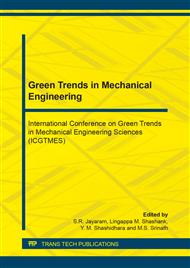p.272
p.278
p.284
p.290
p.295
p.301
p.307
p.313
p.319
Machining Capabilities of Abrasive Waterjet on Stainless Steel 304
Abstract:
Stainless Steels are possessing fabrication flexibility, high hardness, durability, low maintenance, high strength and resistance to heat and corrosion. This alloy steel is extensively used in various engineering applications. Some of the conventional machining techniques results in loss of original properties of stainless steel work material and makes it to behave like ordinary material within the machined surface. Machining of Stainless steels is more challenging due to its high alloying content. Problems such as application of huge coolant supply and poor chip breaking while machining, work hardening in work material, use of cutting tools with varying tool signature, results in enhanced production cost and time. Further, it is important to ensure that there is no machine tool-cutting tool vibration leading to edge chipping of cutting tool. To avoid all these problems, Abrasive water jet machining (AWJM) is used. This paper presents the machining capabilities of AWJ on Stainless Steel304. Influence of dynamic input parameters such as jet pressure, speed of traverse and abrasive flow rate on the depth of cut is investigated. An empirical model is proposed for depth of cut and an error analysis is done with measured and modeled values of depth of cut. It was found that traverse speed influences more than other parameters. SEM images indicated smooth surface at entrance and waviness at exit side. The model proposed predicts the depth of cut more or less accurately.
Info:
Periodical:
Pages:
313-318
Citation:
Online since:
November 2019
Authors:
Price:
Сopyright:
© 2019 Trans Tech Publications Ltd. All Rights Reserved
Share:
Citation:


